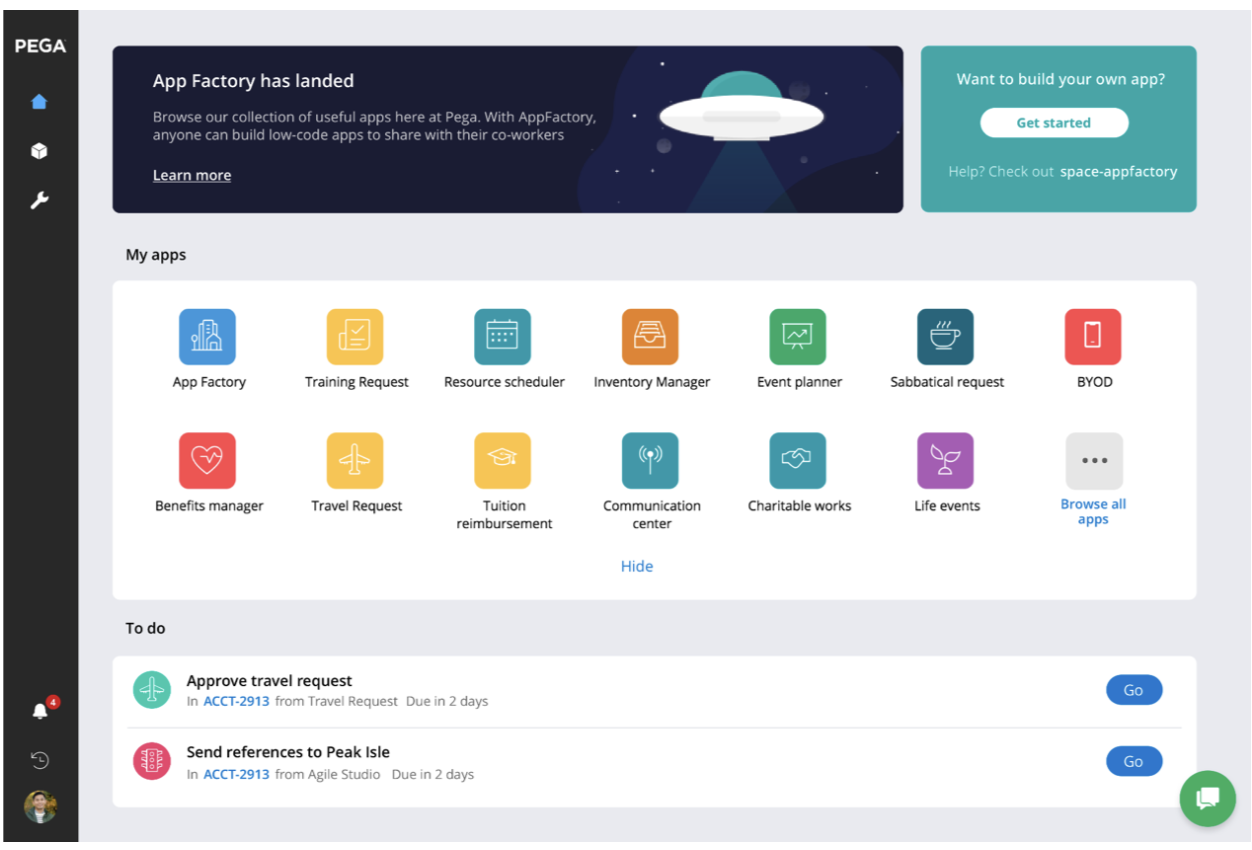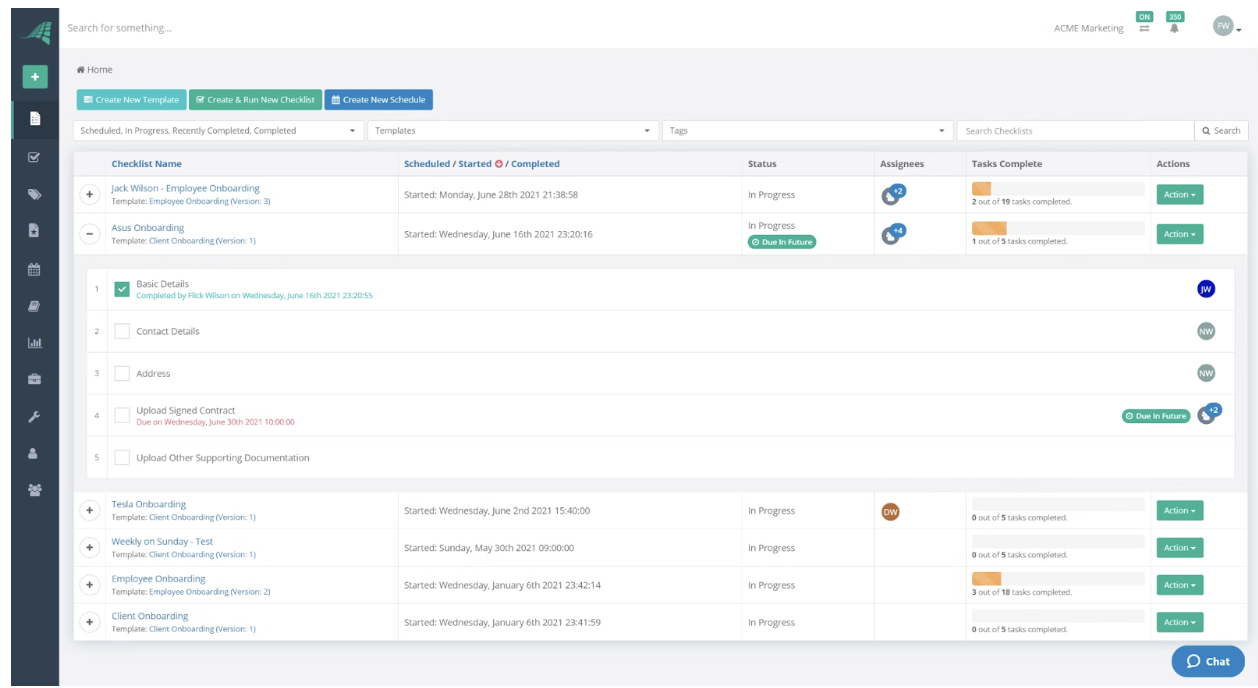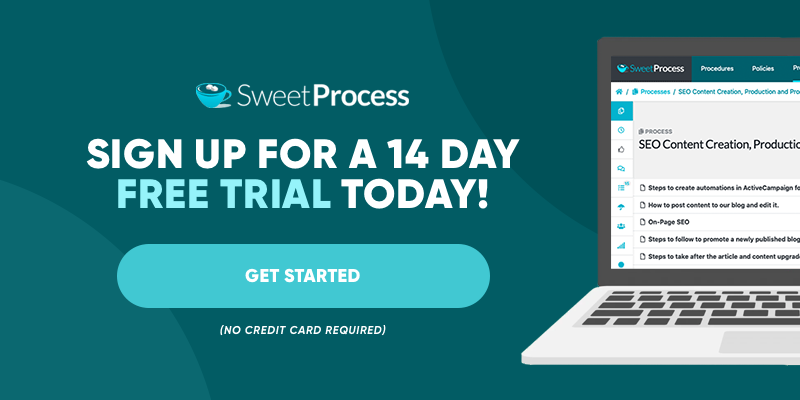Last Updated on February 27, 2025 by Owen McGab Enaohwo
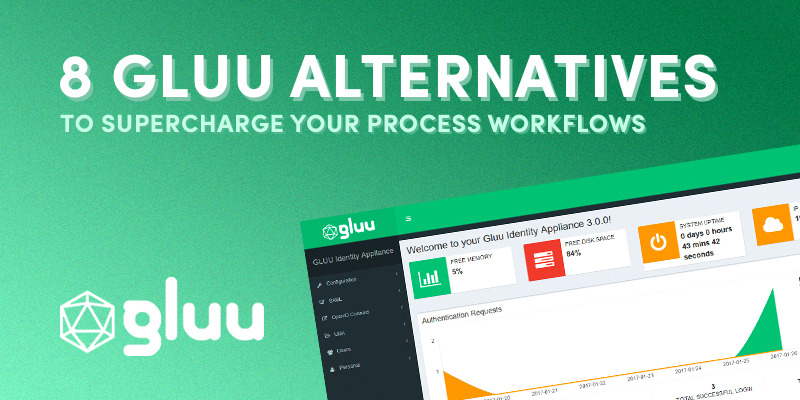
Gluu self-identifies as a process management solution with the tools for small and medium-sized businesses to retain knowledge and stay on top of their process work.
However, if you have used Gluu for some months, you may have noticed that there are a couple of places where Gluu clearly drops the ball.
For example, the Gluu platform is mostly internally based. Processes seem seamless until you need to do work that involves input from external collaborators, who, for security reasons, you cannot add to your workspace. If your organization has public-facing processes, this shortcoming of Gluu might slow down your work.
Moving to new software, especially one as mission critical to your business as a process management suite, is an important decision. To help you make the right choice, this article sets out to review some of the closest alternatives to Gluu.
Gift your managers and team members a process management tool they will really use. Start a 14-day free trial of SweetProcess.
Table of Contents
SweetProcess: The Best Gluu Business Process Management Alternative
Why They Chose SweetProcess: A Review of Case Studies From Businesses Like Yours
Eight Gluu Alternatives
SweetProcess: The Best Gluu Business Process Management Alternative
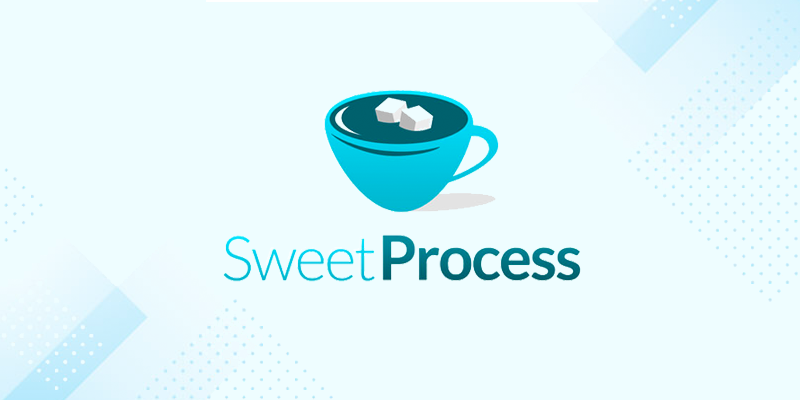
SweetProcess is a business process management (BPM) platform that allows you to capture process knowledge from the heads of your team into standard documents that govern organizational-wide acceptable workflows.
With your processes, procedures, tasks, and policies now centralized and streamlined, it empowers each team member with the correct information they need to carry out their work in a predictable and timely manner.
Besides having one of the most feature-rich, yet simple process documentation, optimization, and task management platforms, SweetProcess is also the easiest to use of all alternatives we considered.
This intuitive usage is by design.
The thinking behind this is that since businesses rely on process management platforms daily to get work done, a product with a complex interface will stand in the way of user adoption.
That ease of use central to the design of SweetProcess is what will quickly make you fall in love with the platform.
Jennifer Schneider, chief design officer at pLink Leadership, fell in love with SweetProcess and gave it a nickname.
“I started calling it ‘Sweet P’ because I love it so much.”
Let’s give you more reasons to fall in love with SweetProcess as we consider some of its strong features.
Pros of SweetProcess
Create documents, procedures, processes, and policies in SweetProces
Using SweetProcess is so intuitive that you barely need a tour to figure things out. Having well-defined documentation for your business is a strong line of defence against tribal knowledge resulting in knowledge silos that sabotage your business.
To create new documentation for your team, all you need to do is click the “Documents” tab in the top navigation bar, then click the “Add” button on the top right-hand side of the workspace.
In the drop-down menu that appears, select “New Document” as seen in the screenshot below:

The process to create procedures is not much different.
Go to the navigation bar at the top of your workspace, but this time click the “Procedures” tab, then “Create Procedure.”

In the screen that appears, enter a title for your procedure.
If you want to add the procedure to a team, click on “Add to teams” as shown in the screenshot below and select the team name from the drop-down menu.
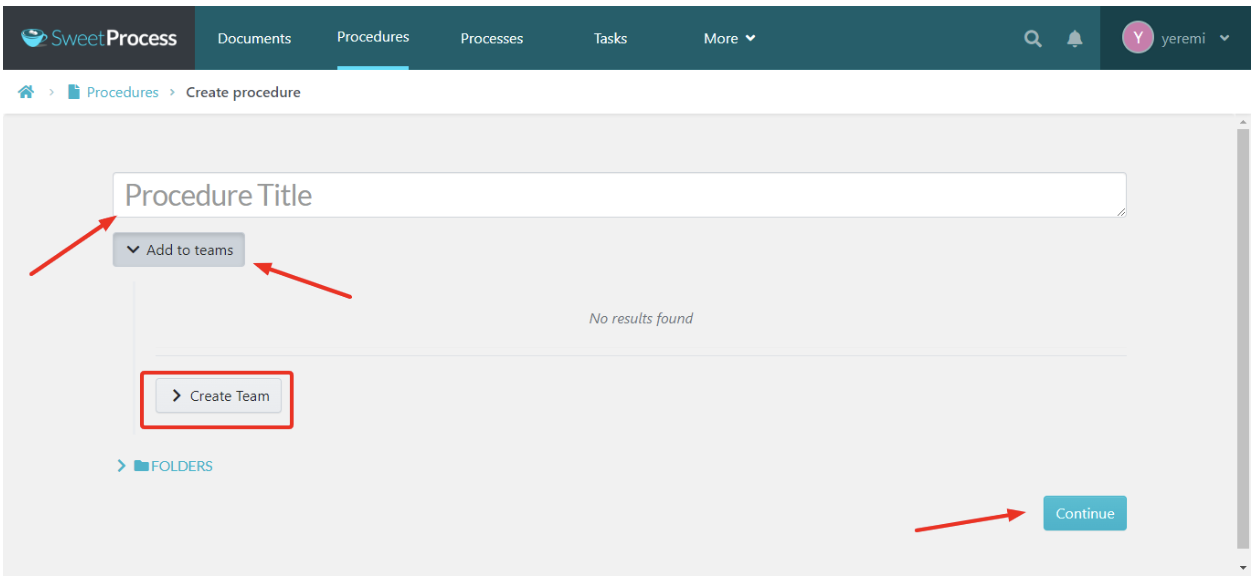
If you do not have an existing team, note that you can create one on the fly by clicking on the “Create Team” button.
After entering those details, click on “Continue.”
In the next screen, enter tags and a description of what the procedure is about. Then click “Finish Editing.”
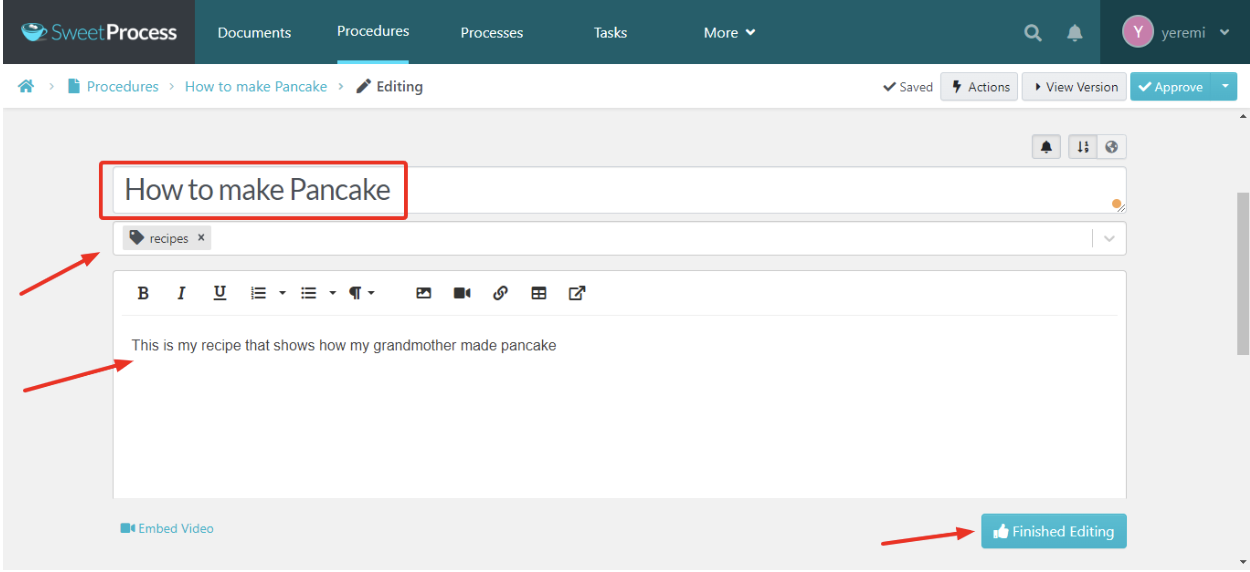
The next screen that pops up shows you the steps list. This is where you enter the steps and the conditional logic needed to complete your procedure.
Click on the “Step” button to add the first step. To add conditional logic at any point, click on the “Decision” button.
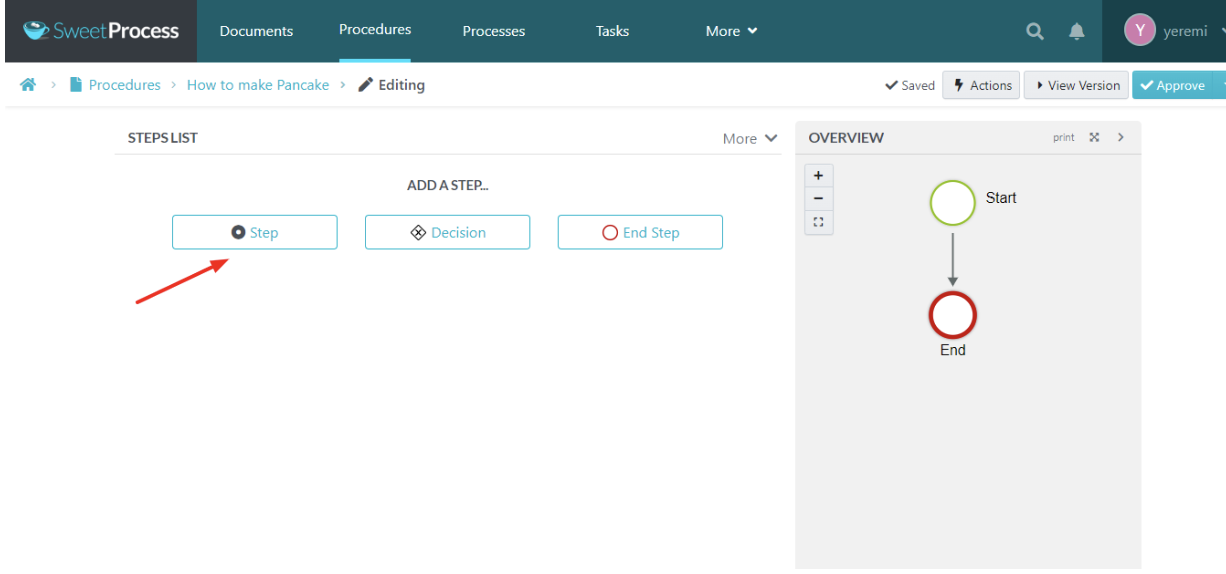
Note how the steps populate automatically inside the process diagram in the right-hand side “Overview” panel.
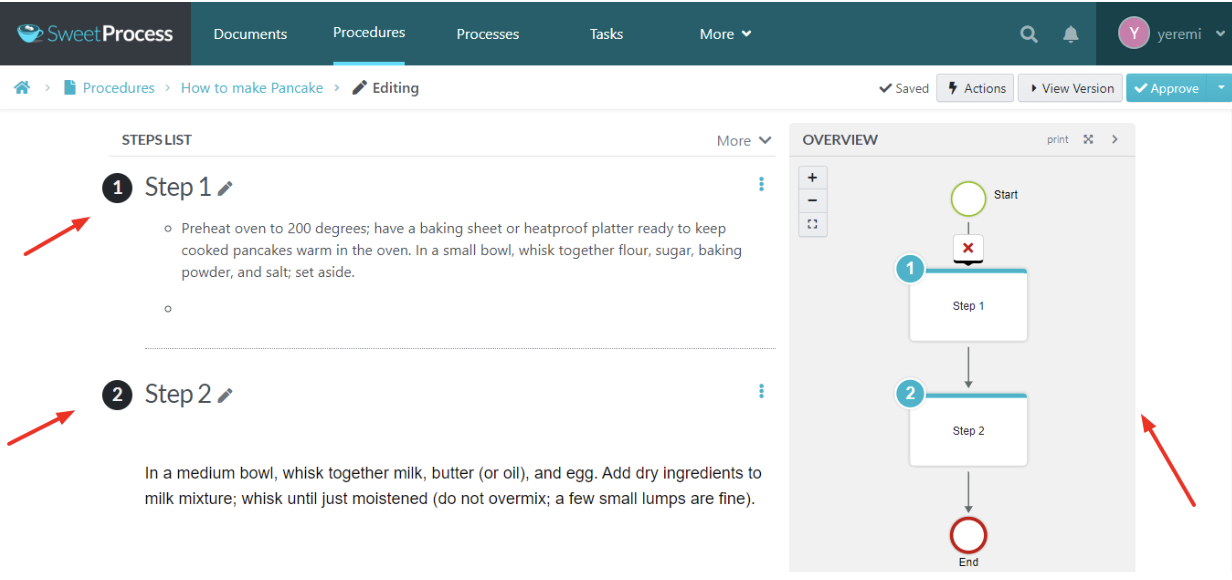
After adding all the steps in your procedure, scroll to the top right of the page and click the “Approve” button to make the draft procedure live.
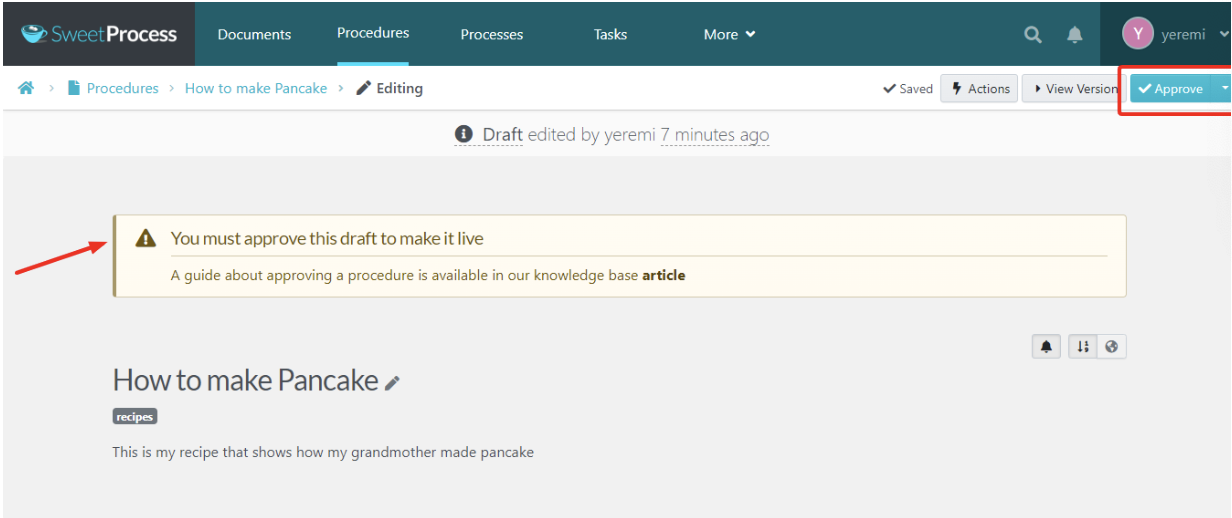
Now that we have a procedure, it is time to create our first process. In SweetProcess, processes are collections of procedures.
To start, click the “Processes” tab on the navigation bar.
On the next page that appears, click on the “Create Process” button in the top right-hand corner.
If you have never created a process before, you will also find a “Create a Process” button in the middle of the page, just below the text “No processes on your account.”
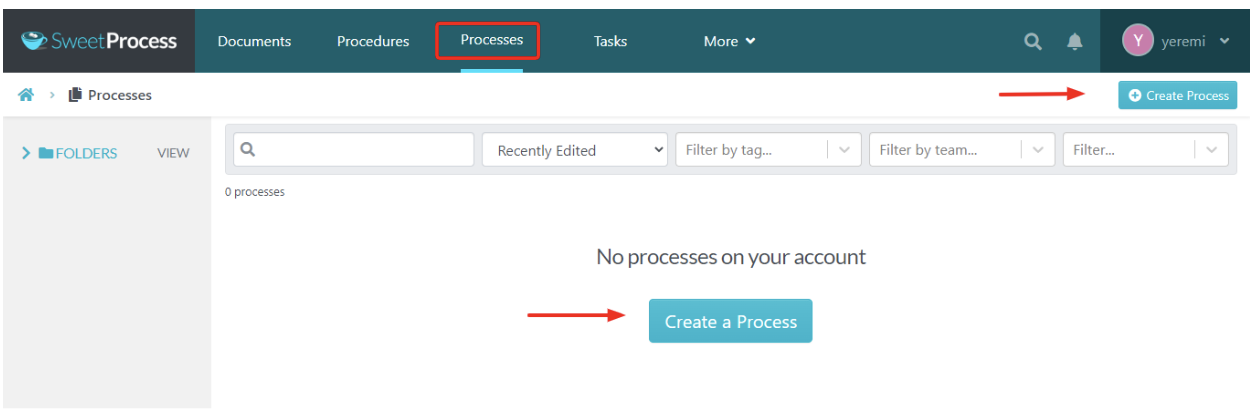
On the next screen, give your process a descriptive name. If you like, you can add the process to a team by clicking the “Add to Teams” button.
If you do not already have a team, clicking the “Create Team” button lets you create a team right there on the same page so you can add the process to that team.
Click “Continue” when done.
Now that you have given your process a name and added it to a team, it is time to add procedures to the process. To do that, click on the “Add Step” button.
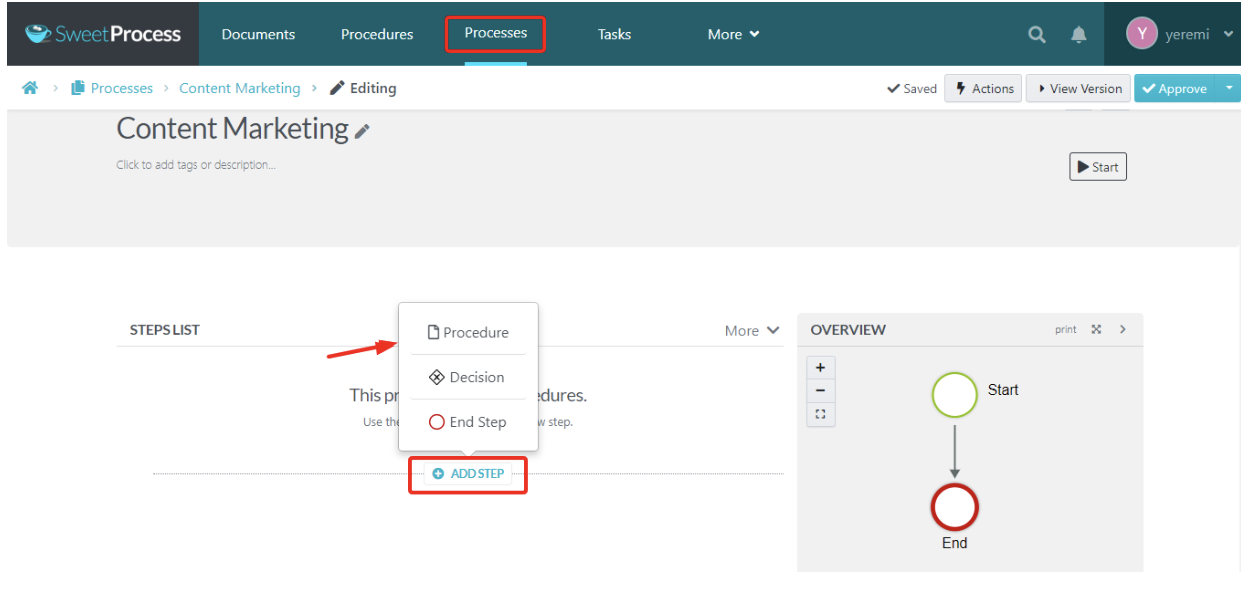
Notice that the dropdown that appears includes options for “Procedure,” “Decision,” and “End Step.”
Select “Procedure.”
In the search box that appears, type the name of the procedure you want to add to your process.
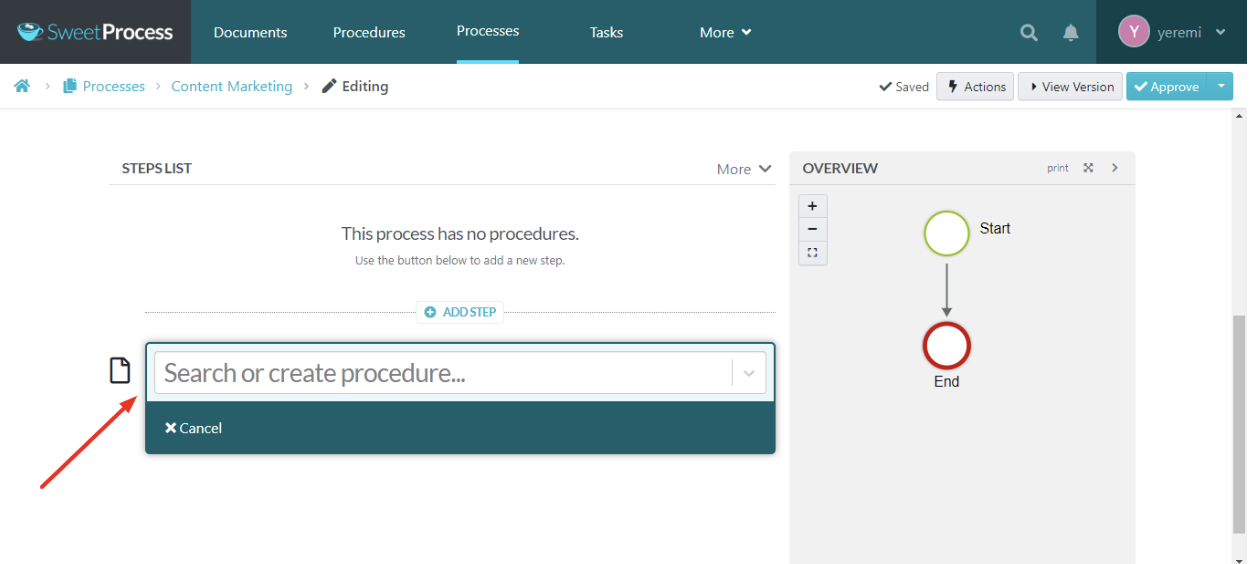
As you type, suggestions will appear if the text you enter in the search box matches existing procedures. Otherwise, you will receive a prompt to create a new procedure in that name.
In this case, we will select our “Content Research” procedure, which we created earlier.
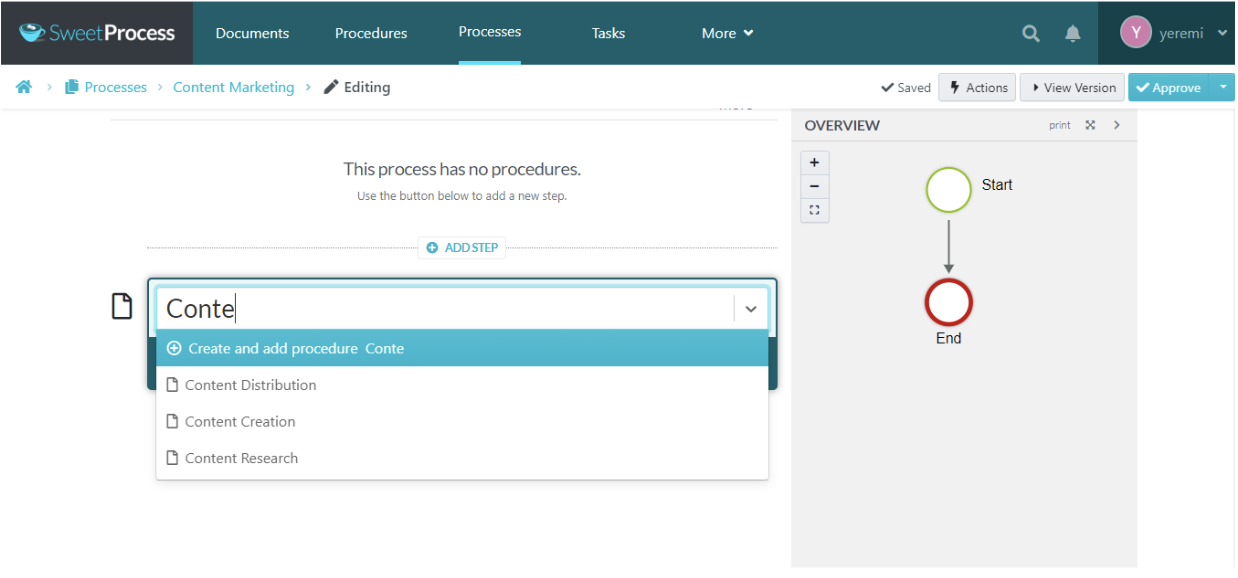
Notice how selecting the “Content Research” procedure adds it automatically to the process “Overview” panel on the right.
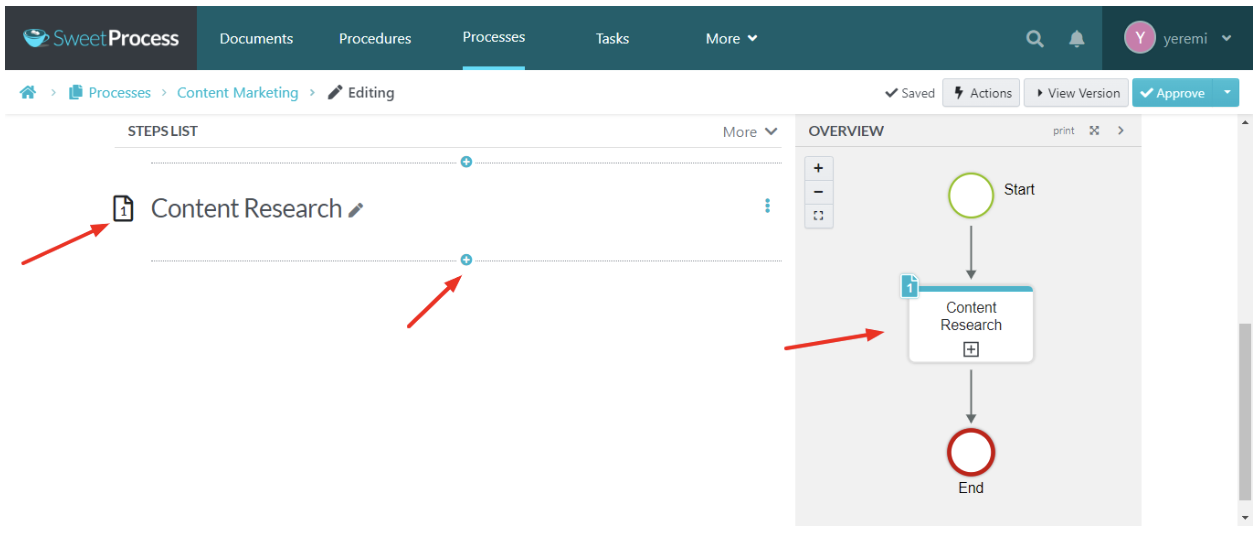
To add additional procedures to your process, click the “+” sign above or below the first step.
Amy Walls, president and financial advisor at Thimbleberry Financial, cannot stop talking about how using SweetProcess improved their documentation. She recounts how the platform helped their team easily spot ways to improve processes that were formerly doc based.
“Once we started plugging things into SweetProcess, I found the team was finding, ‘Oh, these other documentations are missing so many steps,’ and we found part of the things that makes our processes and procedures more difficult…because we do the comprehensive plan and wealth management, there’s lots of crossover between things.”
Import Existing Procedures into SweetProcess
What if you already had procedures created for your team outside SweetProcess?
SweetProcess allows you to import procedure documents in .docx format.
To import a document as a procedure, click on the “Procedure” navigation tab.
On the “Create a Procedure” right-hand button, click the downward arrow and select the “Upload Document” option.

In the pop-up that follows, browse your computer and upload a procedure document in .docx format.
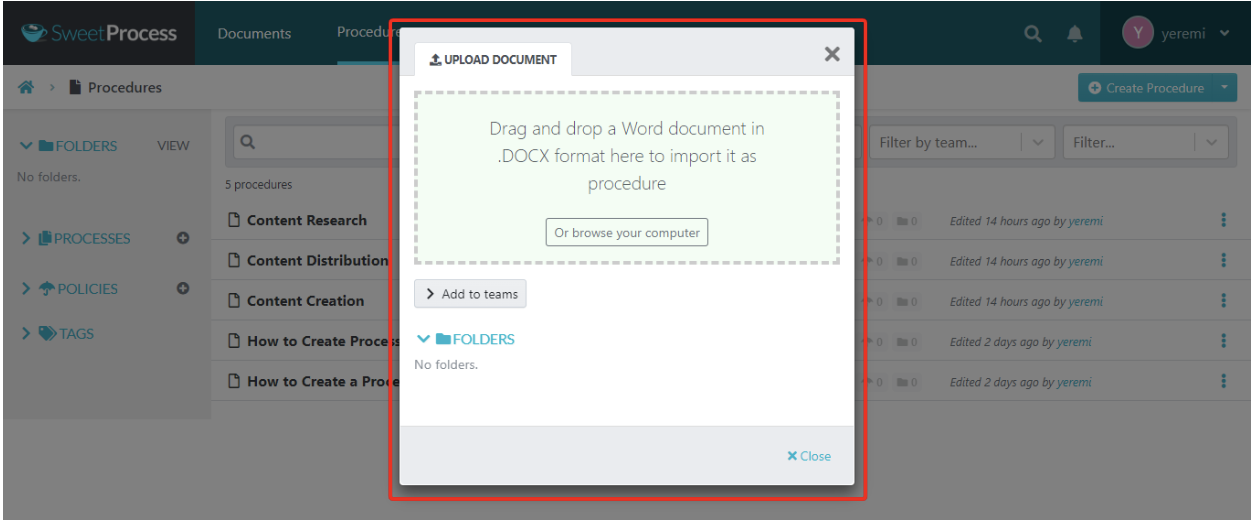
Automatic Flowcharts From Procedures and Processes
In case you missed it earlier, SweetProcess generates a flowchart simultaneously while you document procedures and processes.
Flowcharts provide a visual reference of the business knowledge you document, improving your understanding of how the procedure or process runs.
For example, if you create a process that documents how your team carries out content marketing, you might include the following procedures as steps:
- Keyword selection
- SERP analysis
- Content research
- Content brief creation
- First draft writing
- Content review/edit
- Final draft writing
- Visual assets design
- Content publication
- Content distribution
After creating this process, SweetProcess automatically generates the ten-step flowchart shown in the screenshot below:
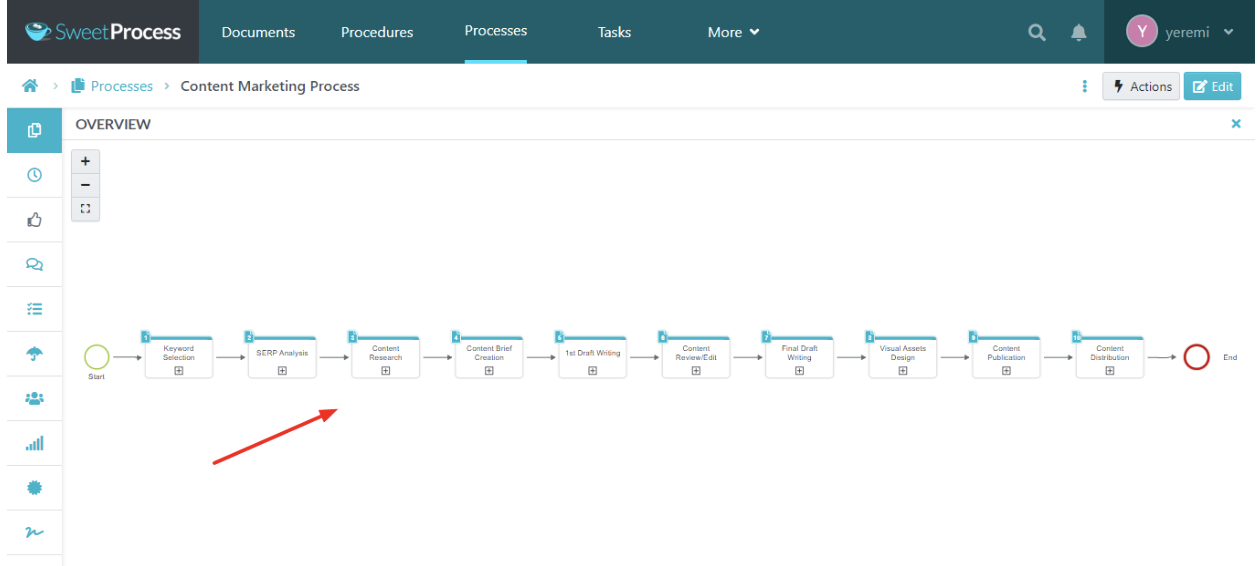
Such a bird’s-eye view of your process gives you a top-down understanding of the process and is also invaluable for process improvement and management.
Raise operational efficiency in your business. Start a 14-day free trial of SweetProcess.
Export Procedures and Processes for Offline Viewing
We have considered how you can create a procedure in SweetProcess by importing a Word-based procedure. But what if you want to export a procedure from SweetProcess? Perhaps you want to move to a different platform (no, we do not hold you hostage).
SweetProcess makes it easy to print each document, procedure, or process. You can also export your documents, procedures, and processes in Word, PDF and HTML formats.
To export a SweetProcess document in any of those formats, click the “Actions” button on the top-right of the workspace and select the format you want to export in.
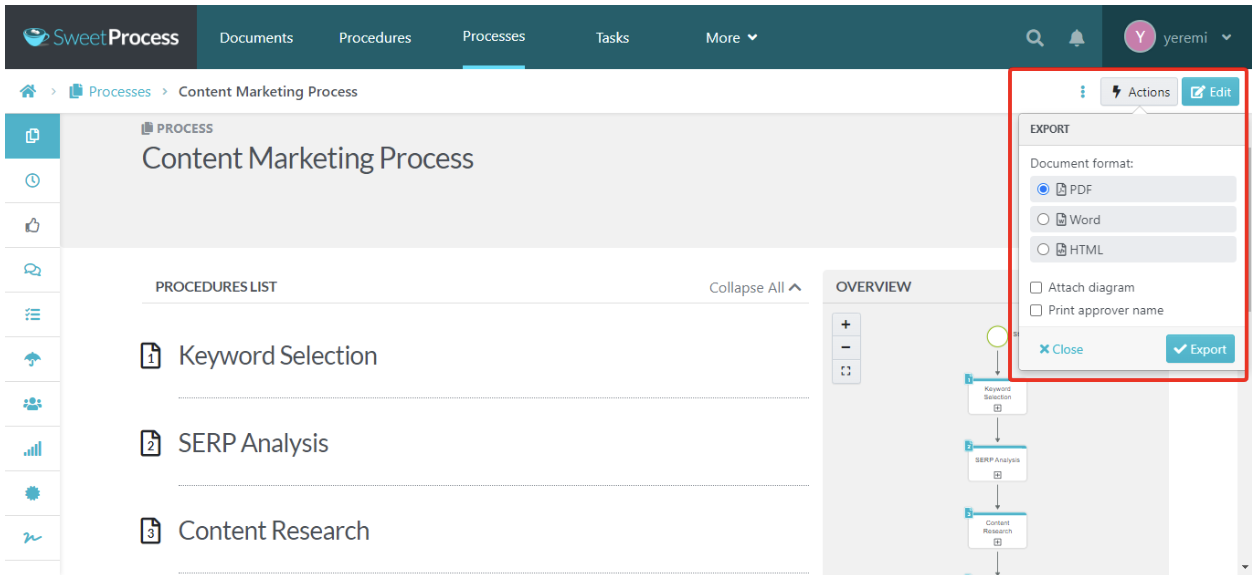
Then click on the “Export” button.
Create a Standardized Knowledge Base
A knowledge base software is a repository of company-specific information that enables both internal and external audiences to learn more about the company, discover solutions to problems they are facing with your products and services, and even fix those problems without having to speak to customer support.
For internal audiences, knowledge bases are essential in entrenching quality control and predictability in organizational output. The consistency of results that this engenders goes a long way in building customer loyalty and trust.
To create a knowledge base in SweetProcess, click the “More” option in the top navigation bar of your workspace and select “Knowledge Bases” in the dropdown as seen in the screenshot below.

On the next screen, simply click the “Create Knowledge base” button.
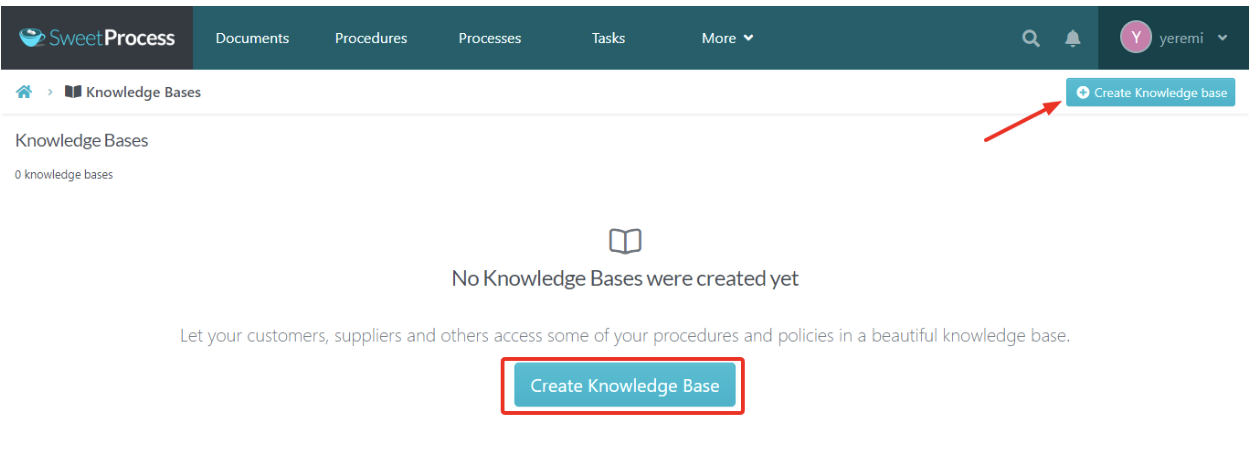
Now enter a title for your knowledge base in the text box shown below, then click on “Continue.”

On the next screen, select the drop-down option of whether your knowledge base is private to your organization or open to anyone on the internet.
Note that you can also set whether readers can leave comments or feedback below each knowledge base article.
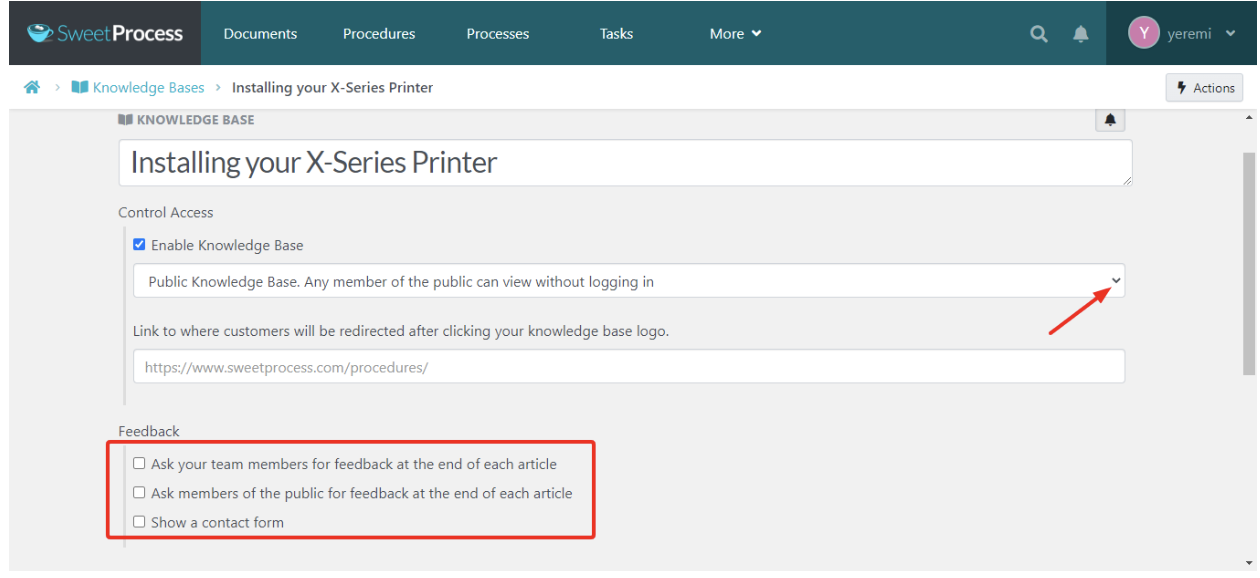
Stephanie Chavez, chief marketing officer at Zen Media, found that using SweetProcess’ knowledge management feature reduced the likelihood of the organization being held hostage when people who knew how to perform certain tasks were indisposed.
By creating a detailed knowledge base that references all their procedures and processes, Zen Media turned their business into a modular system with replaceable parts where anyone with authorization can step in and complete a process by simply accessing the steps outlined in SweetProcess.
“You’re doing things well but there’s no hub to go to and send people to… I have been making a process for each step in SweetProcess so that if Brandy happened to be out, Natalie could easily pick up and keep moving forward so that there’s no gap.”
Discover how SweetProcess can quickly spread best practices across your operations. Take our platform on a free test drive for 14 days.
Assign Tasks to Your Team and Track Their Progress
While procedures and process documents are templates of how something is done, a task is a single instance of that procedure or process assigned to someone with a deadline for completion.
It makes sense that beyond being a process automation software, SweetProcess is also a task management software that allows you to assign tasks to teammates and track their progress.
For example, let’s consider the “Content Brief Creation” procedure we created earlier.
To turn that procedure into a task, click the “Start” button highlighted in the screenshot below, then describe your task in a few words.
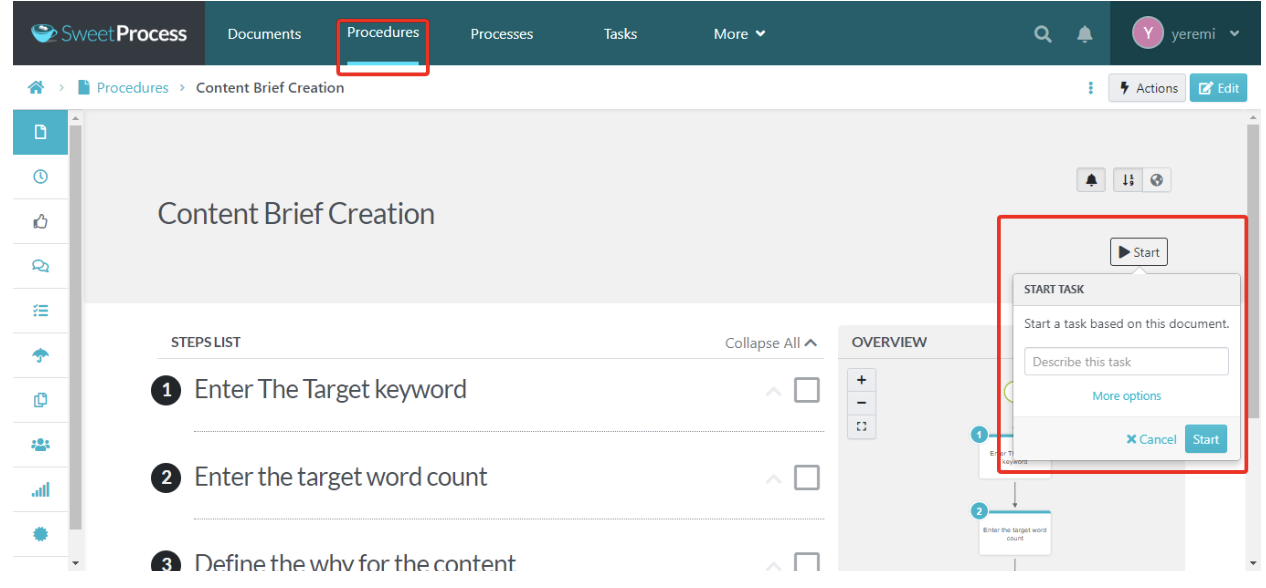
To set more options, click on the “More Options” button.
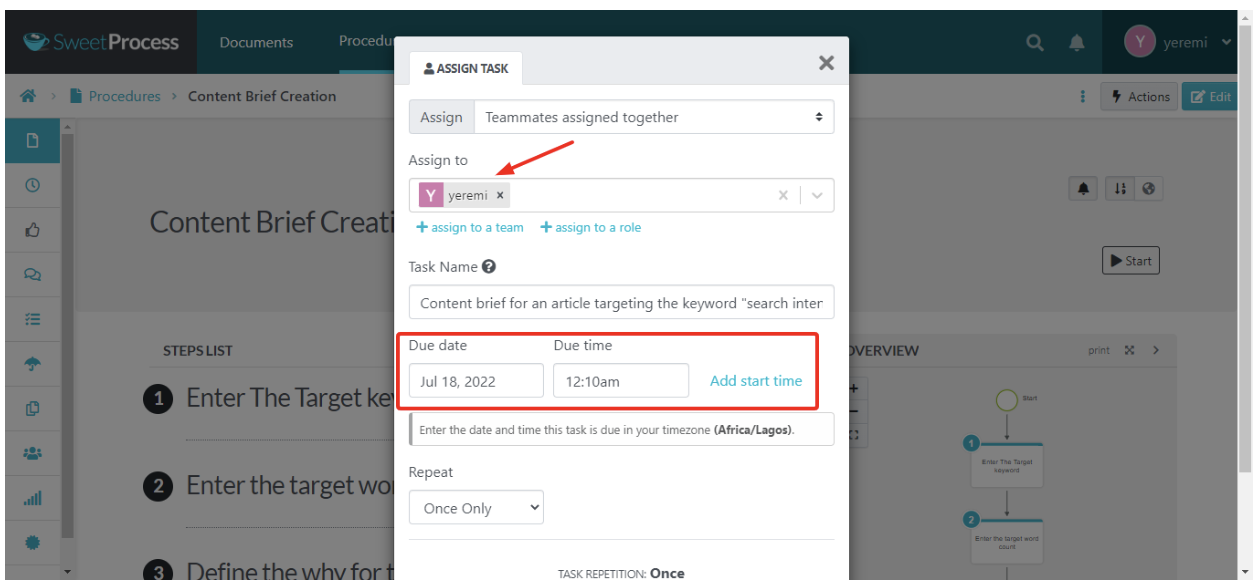
Here you can assign the task to an individual or team, and set the task name, schedule and recurring frequency.
Done? Click the “Assign Task” button and SweetProcess will assign an instance of the procedure to the assignee.
Adding and assigning a task from the “Task” menu tab is intuitive.
First, click on “Add Task.” In the pop-up that appears, select a procedure you want to assign as a task from the list of existing procedures or create a new one by selecting “Add new Procedure.”
Next, click on “Select Teammate” to assign the task to a colleague.
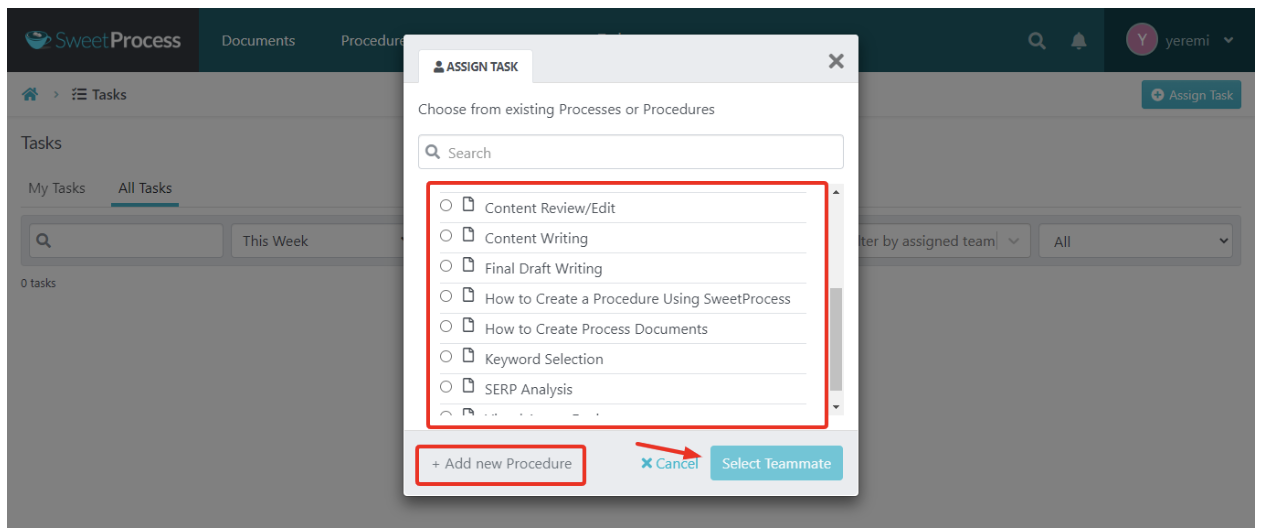
After entering the assignee and supporting scheduling information, click on “Assign Task” to add the task to the queue.
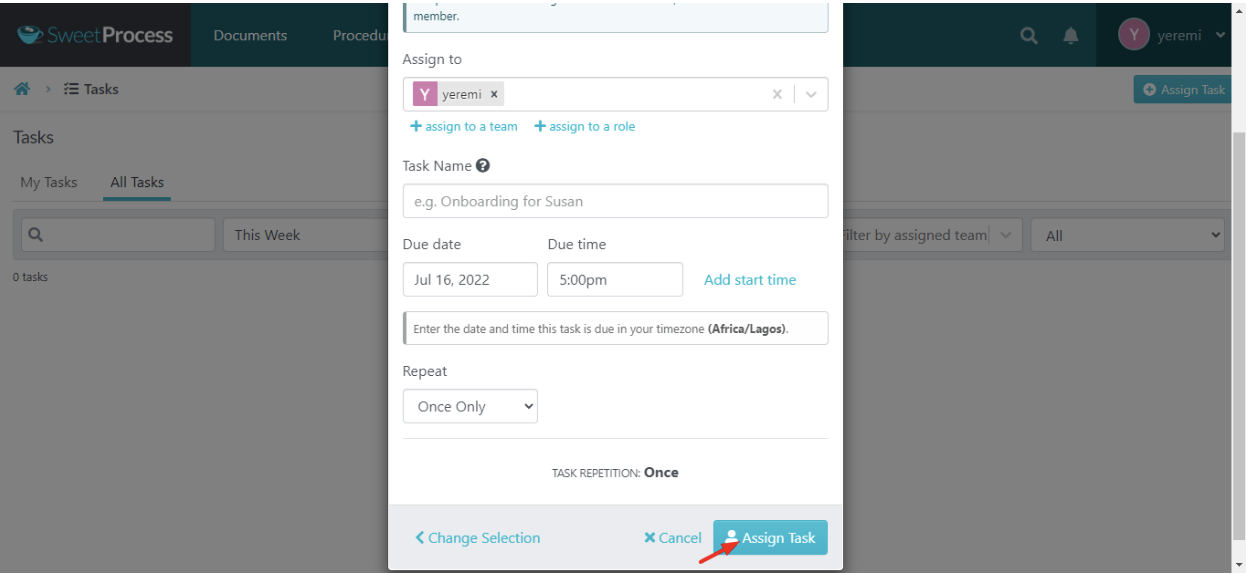
Version History Support
SweetProcess’ support for version history allows teammates to have a clear picture of who changed a document with a timestamp to show when the changes were done.
Apart from serving as an accountability measure, it also helps process owners roll back changes if needed, or at least monitor how policies, procedures, and processes have evolved.
The screenshot below shows how a document has changed over time, and which team members made the changes.
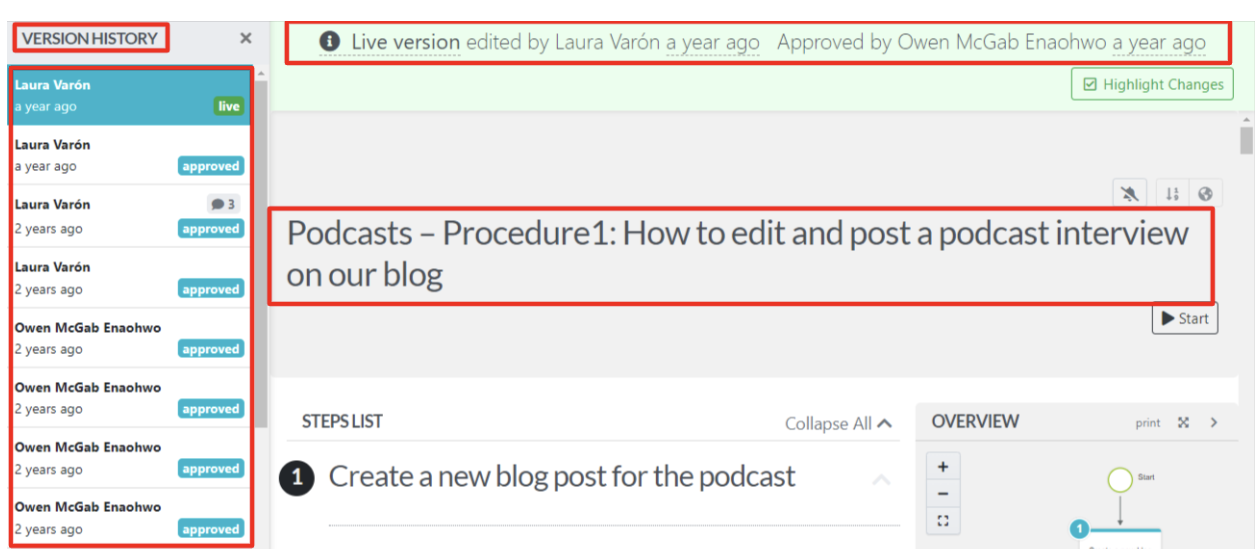
Don Houk, president at Next7 IT, shares how using SweetProcess was a game changer in improving process transparency and accountability at their construction business.
“Not having the accountability of who did what and when was probably the breaking point. We saw the need ourselves, and our customers wanted the accountability that comes with having a checklist that has a timestamp date next to it of when things occur.”
After evaluating several products, the team at Next7 IT settled on SweetProcess. Don explains:
“SweetProcess came from a search that we did, trying to identify a better way to manage our processes. Prior to SweetProcess, we were just doing everything in Word documents and that was okay. It was very flexible, but it had several problems with it. We couldn’t consistently take that process and throw it into a checklist. We couldn’t see who had executed it at a particular time.”
Like Next7 IT, many teams similarly committed to improving their documentation and process improvement game have found SweetProcess to be the solution of choice.
Pricing
SweetProcess has the most straightforward pricing model in the process management space.
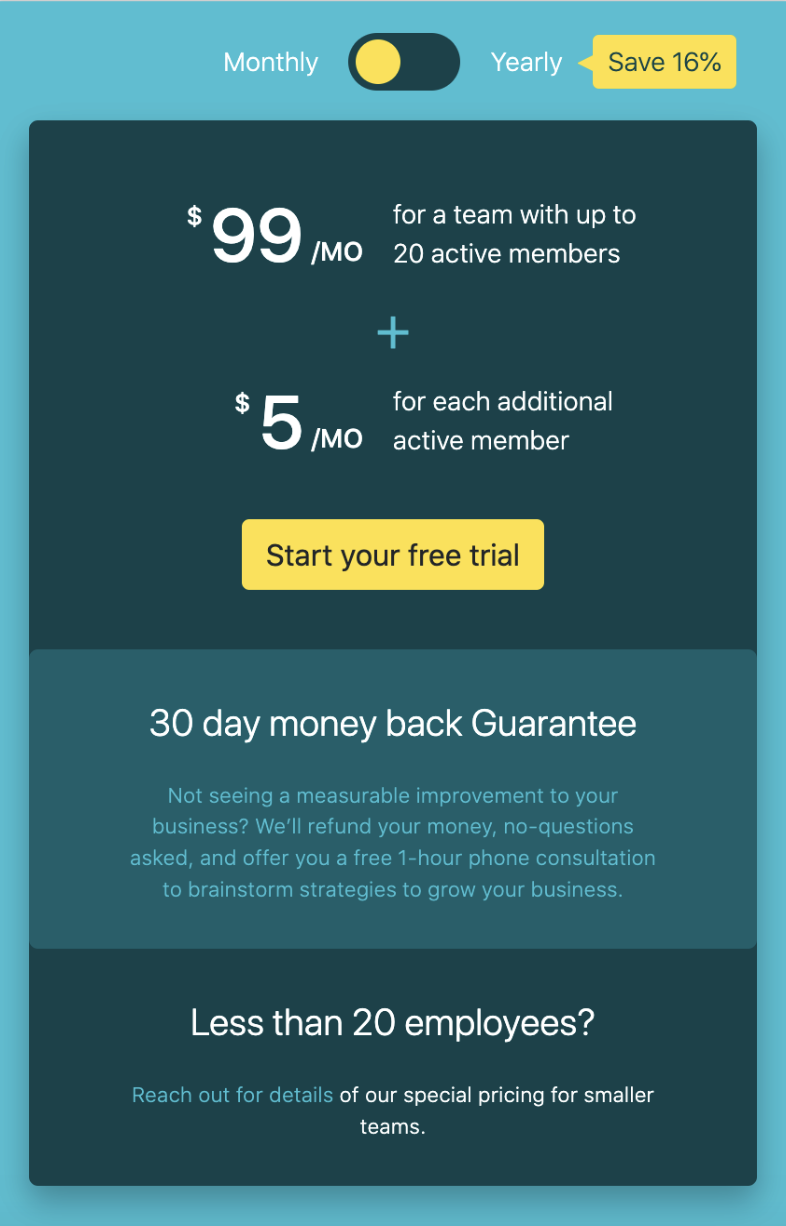
For a fee of $99 per month, you get access to an account with 20 active users, only paying $5 per month for each additional active user.
Want to save even more? Pay for one full year and save 16%. If you have less than 20 employees, you can reach out to SweetProcess to get special pricing for smaller teams.
Another interesting feature of SweetProcess is the one-size-fits-all pricing model. Everyone gets the same package and the same set of features—no limited editions. With an offering like this, if we call SweetProcess the best deal for business process management (BPM) for small businesses, we would be making a fair assessment.
Why not get started with a 14-day free trial to see how everything works? No credit card is required, and you can cancel at any time.
Kissflow

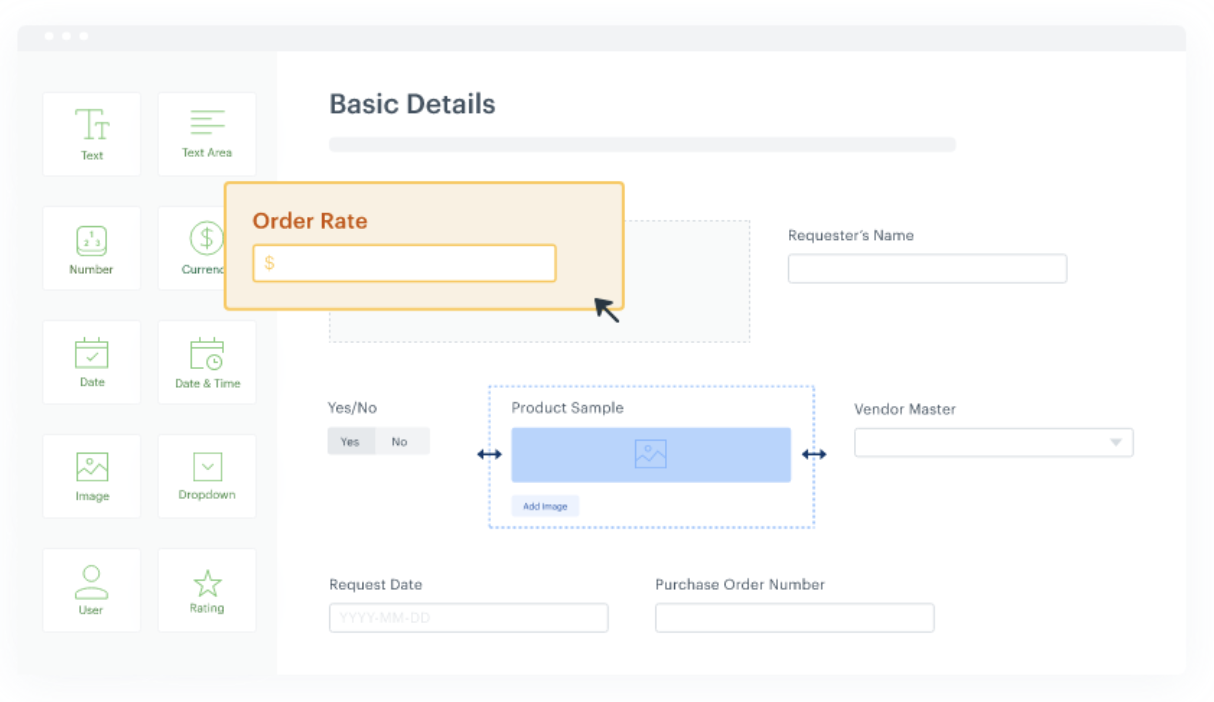
Kissflow is a workflow management software that positions itself as a simple solution to help you streamline all the workflows in your business in one place. It allows you to leverage three major capabilities: workflow management, process management, and case management.
Kissflow provides both a flexible and structured approach for business process management needs, making it adaptable to the needs of businesses and not the other way round. With its no-code leanings, users can create their own apps and workflows, minimizing runs to the IT department.
Some of the notable use cases for Kissflow include procurement cloud, digital workplace, project management, case management, digital workplace, process automation, app development, and digital transformation.
Pros of Kissflow
No code development
Kissflow provides the essential tools and platform for employees with no-coding background to create no-code applications quickly. Supporting this ease of implementation are ready-made use cases that come with the platform.
Real-time analytics
Kissflow includes custom metrics that keep you informed of real-time performance conditions of each workflow process. This is invaluable in helping you diagnose processes to determine how to improve them.
Cons of Kissflow
Multiple membership levels with limited feature access
Some of the very good features are either limited in Small Business and Corporatelevels or exclusive to the Enterprise levels. Since the pricing page does not make this clear, it could cause an ambush situation. As an example, organizations with thousands of employees using the public forms feature would be prohibitive unless one was on the Enterprise plan.
Integrations via Zapier
While Kissflow has thousands of integrations, they run through Zapier. This makes it less seamless and adds an extra layer of cost when users exhaust Zapier’s basic allowance.
Buffering with heavy usage
Users complain of increased usage resulting in significant drag that affects overall process cycle time. This is especially noticeable when progressing through the flow or submitting a form.
Pricing
Kissflow gives users three pricing options, namely Small Business, Corporate and Enterprise plans.
As the name Small Business plan implies, this plan suits startups and smaller companies looking to manage their workflows and optimize their processes. The monthly fee starts at $18 per user, for a minimum team size of 20 persons.
That means the minimum monthly fee is $360. When you toggle the payment terms to annual, you will notice that the price changes to $10 per user, for a minimum of 50 users. That puts the minimum annual price for the small business plan at $6,000, billable at once.
The Corporate plan is for “growing organizations looking for a single work platform to solve multiple-use cases.” Subscribing to this plan will cost you $20 per month for a minimum of 100 users. This totals $24,000 annually. Note that there is no monthly payment option for this plan.
The Enterprise plan targets mid to large companies that need to scale the entire business. To get the price for this option, you need to contact Kissflow for the quote.
Workato

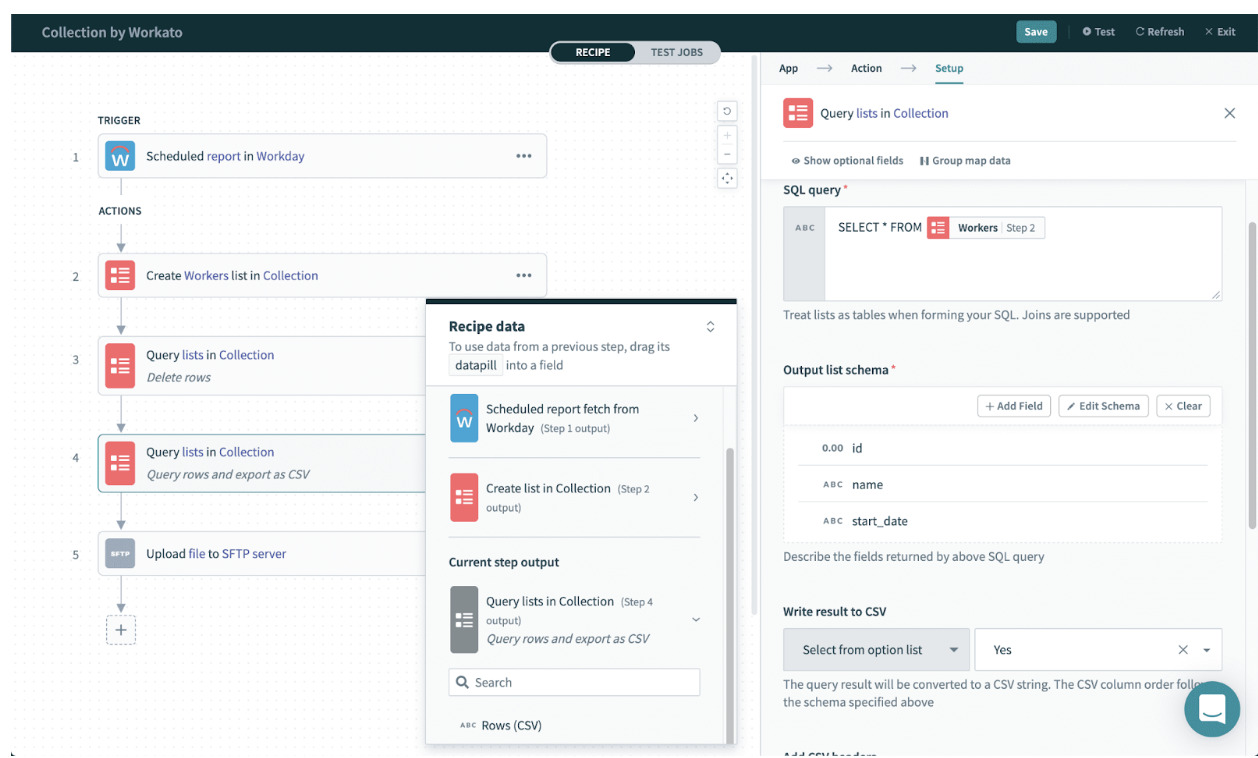
Workato is an enterprise workflow automation platform ideal for larger businesses with complex workflows. It provides a single low-code and no-code platform that combines a mix of API-based and UI-based automation that empowers businesses to go beyond automating single tasks to automating entire processes.
Besides connecting to over a thousand apps, databases, files, big data, APIs, and low-code platforms, Workato enables teams to build connectors to cloud and on-prem apps with ease using software development kits (SDKs).
A good way to consider Workato is a cross between a business process management platform like Sweet Process, with an integration platform like Zapier. You integrate apps and automate workflows in one easy-to-use application.
Pros of Workato
Enterprise-grade security and scaling
Workato encrypts all information on the platform at rest and in transit using a strong encryption algorithm (AES-256). With customer data, it employs a double-encryption technology hosted by cloud providers.
Cloud, on-prem and ERPs implementation
Workato allows you to create apps that make it easy for your teams to interact with any combination of cloud services, on-premise systems, ERPs, etc.
Intuitive user experience (UX)
Similar to SweetProcess, the user interface of this platform is easy to figure out for new users.
Its impressive user experience is further enhanced by bringing tasks and actions required by your team into the tools they already use. For example, it has an enterprise bot platform called “Workbot” that runs on Slack, MS Teams, and FB Workplace.
Cons of Workato
Expensive, confusing pricing model
Some user reviews we evaluated seem to suggest that Workato’s per active recipe pricing strategy can cause a fast build-up of significant charges or put IT in a distracting situation where they have to worry about switching recipes on and off.
Custom demo experience/free trial
Instead of a free trial offer right off the bat, prospects get periodic pop-ups inviting them to watch a demo video to see the platform in action. Note that you have to specify how you intend to use the solution in your demo application.
Unsuitable for smaller organizations and solopreneurs
Workato’s target market, based on their pricing model, appears to be rather midsize to large organizations with enough IT budget. It is doubtful that smaller businesses can find a scenario where using Workato would be cost-effective.
Pricing
Like many enterprise SaaS businesses, Workato does not disclose its price on the pricing page but provides each prospect with a custom estimate upon their request for a quote.
Our research shows that the last time they published their price on their landing page seems to be as far back as October 2020.
With their clever copy, “Simply pay for what you use,” it is easy to conclude that you are getting a great deal.
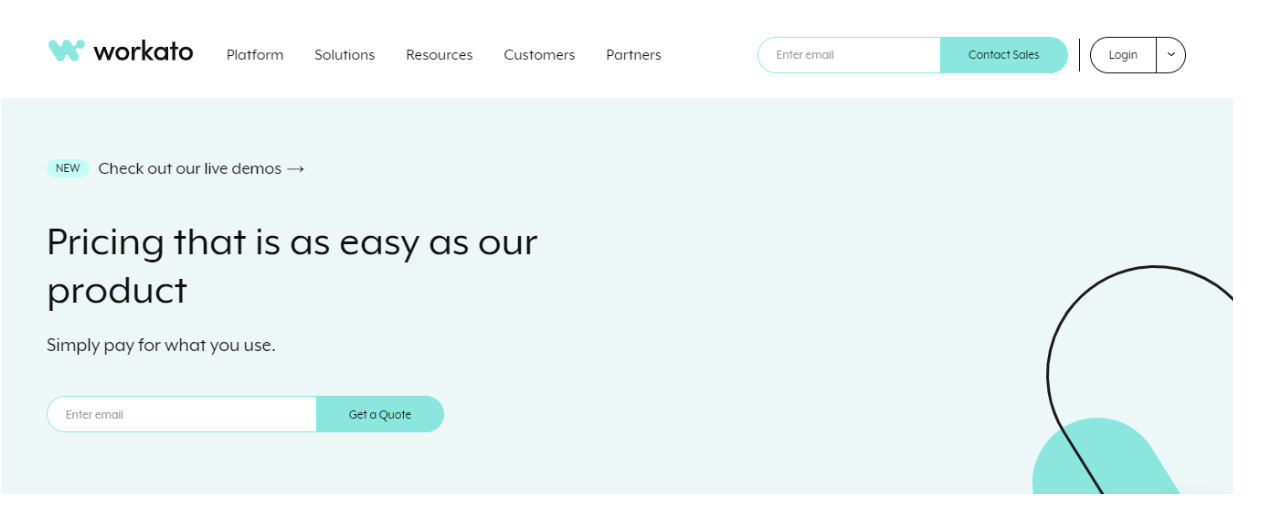
But it is not that simple.
If you are familiar with most cloud platforms, you should know by now that those billings quickly add up.
Despite their cloaking the actual cost for their service, we can estimate that annual pricing for Workato runs in the $15,000 to $60,000 range, depending on how many integration templates and connectors you use.
How did we arrive at those numbers?
Our research for this article turned up some client testimonials. For example, on the software users community Capiche, several Workato users disclosed how much they cough out annually.
ProcessMaker
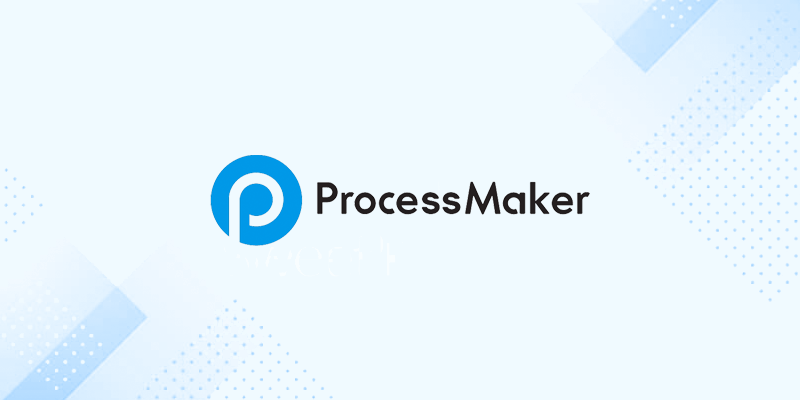
ProcessMaker is an open-source low-code workflow automation and business process management (BPM) platform that empowers business users to ideate, design, and deploy solutions to complex workflow problems.
The solution, which is deployed on-premise or in the cloud, provides users with a drag-and-drop interface to automate business processes. It also connects and extends the capabilities of third-party systems, reduces operational bottlenecks, and delivers digital agility to businesses at scale.
Pros of ProcessMaker
Responsive support team
While this is not directly related to their product, the quality of support a vendor provides to their customers plays a key role in how deeply customers can utilize the product to meet their goals.
When issues come up during a process automation adoption, you need a vendor willing to take you by the hand through the maze.
Great user experience design
The layout of ProcessMaker is familiar, which makes it easier for a user to figure out how the application should work. For example, the user interface design is similar to that of email applications, which lends some generic familiarity to the application.
Free community version
ProcessMaker has a free community version that provides a platform for users to try out the functionalities of the product before making a purchase decision. This is better than a time-limited free trial that puts business users in a race against the clock to learn the product and adapt it to their needs.
Remote access without VPNs
It is possible for workflow users to connect to ProcessMaker without the need to use a VPN as is the case on some platforms.
Cons of ProcessMaker
Steep learning curve
A lot of beginners find ProcessMaker challenging to learn and master. In an age where SaaS products pride themselves on ease of use, there are a lot of improvements needed by this alternative to level up.
This situation becomes worse if the documentation and knowledge management practice of the application is poor.
“Powerful, but buggy:”
Many users observe that they have a buggy experience using ProcessMaker.
This is likely a result of poor software development practice where codes are released in a hurry to front-load new features without recourse to quality.
While most agree that the application is powerful, the difficult learning experience often means that most of the capabilities remain unexplored.
Complex report-creation process
Extending from the steep learning curve disadvantage of this application, users observe that performance is impacted by their inability to create reports early on in their use of the application.
Pricing
ProcessMaker breaks down its pricing into four distinct product categories. There is the “Low Code Platform,” “Banking Solutions,” “Higher Ed Solutions,” and “Embedded Solutions.”
Strangely, though, clicking on “View Pricing” on the category tabs takes you to an opt-in form page to speak to the relevant Platform Team. If that sounds familiar, it is because that is the same cloak-and-dagger stuff we witnessed with Workato.
As recently as October 2021, ProcessMaker’s Standard plan costs $1,495 monthly, billed annually. That put the annual pricing for the Standard plan at $17,940.
On the other hand, during that period, the Enterprise plan costs $2,479 monthly, also billed annually, which sums to $29,748.
While we cannot guarantee that this pricing as of October 2021 is still current, it can give us a ballpark figure of what the current pricing could be.
Pega Platform

Pega Platform identifies as a real-time decision and workflow automation platform that helps organizations adapt to the increasing day-to-day complexities of work.
One thing that helps Pega stand out is how the platform uses a combination of automation, AI, and customer engagement to solve businesses’ most pressing process challenges.
From the name, Pega Platform, it is easy to tell that this is not a single software but a collection of software. Amongst other solutions, Pega Platform includes low-code application development, Robotic Process Automation (RPA), case management, and BPM.
The scope of these products enables organizations to personalize engagement, orchestrate work, automate services, and streamline operations in a manner that bridges the gap between customers and businesses and maximizes profit.
The premise is simple: creating apps to support business processes should not be hard.
Pros of Pega Platform
Excellent integration capabilities
Pega Platform integrates easily with other tools and systems. Recently, Pega launched front-to-back integration capabilities that embed self-service workflows into any front-end channel. Building on Pega’s open API architecture, these features help businesses speed up the development of self-service experiences to meet increasing demands from customers and employees without putting an extra burden on IT.
Reduced time to market
Pega’s center-out methodical approach helps organizations quickly implement new projects, avoiding common mistakes that lead to delays.
Improved business process agility
The low-code capabilities coupled with the agile leanings of the Pega Platform means that less time is spent on routine maintenance tasks, allowing developers to shift focus to higher-value tasks.
This means faster time to value, both for development teams and for end users who utilize the apps created.
Product functionality and performance
Poor application performance can result in users encountering poor resource utilization. That is why Pega’s user experience performance optimization strategies are so important. Users can leverage one of Pega’s inbuilt performance tools like AES or PDC to identify performance issues. Once spotted, IT can redesign the application flow to address the performance problem.
Cons of Pega Platform
User interface limitations
Several users complain that while fit for purpose, the UI of the Pega Platform could be upgraded to bring it to par with that of similar products. Some users have noted critically that the current generated UI is not lightweight. This is not helped by the fact that the reporting feature depends on the same engine as the UI.
Cost is prohibitive
While Pega Platform is a great system, with the pricing model for modules, it is very easy for the cost of running on Pega to become prohibitive, especially for small businesses.
Less than ideal support
The support from Pega’s Platform is not ideal and can be improved.
Before getting support to resolve major functionality issues, your version of Pega must be upgraded to the latest available version. This is often not practical when dealing with systems that are already in production.
Server-side interactions for every functionality
Most actions make server calls. This adds to the clunkiness of the application and has an effect on how smoothly user interaction with the application goes.
This likely increases the CPU power needed to run the application, which adds to the infrastructure cost.
Pricing
Pega Platform has three packages, namely the “Low-code Factory Edition,” “Standard Edition,” and “Enterprise Edition.” Let’s see how costs for these packages differ.
The Low-code Factory Edition allows users to “build simple workflows to improve the productivity of individuals and workgroups.” It costs $35/user monthly, with a minimum of 500 named users billed annually, or $0.45 per case per year, with a minimum of 350,000 cases per year.
That puts the minimum annual cost of this plan at $210,000 when billed per user, or $157,000 when billed per case.
The Standard Edition is suitable for building “moderately complex departmental applications requiring multiple channels and advanced automation.” Billed per user, the cost for the Standard Edition is $90/user/month, also with a minimum of 500 users, billed annually. Billed per case, this plan costs $0.80 per case for a minimum order of 350,000 cases.
This puts the pricing for the Standard Edition of the Pega Platform at a minimum of $540,000 per year when billed per user, and $280,000 per year, billed per case.
The third Pega Platform plan is the Enterprise Edition. Pega Platform does not disclose the price of this plan on the pricing page but customizes the package based on the customer’s needs.
Pipefy

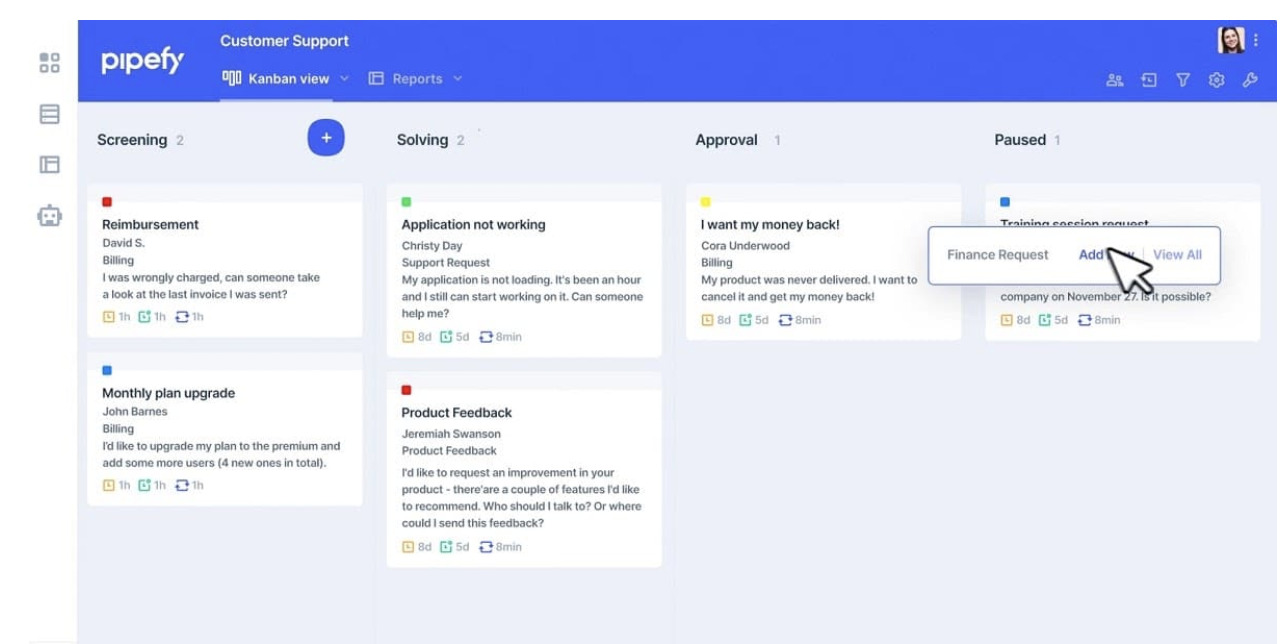
Pipefy identifies as a no-code process orchestration platform designed to manage and optimize business processes. The platform seeks to empower every user and process owner in an organization to carry out and improve work in an efficient manner.
With hundreds of re-built processes, Pipefy users can design and customize complex business processes in minutes. With its public-facing forms, anyone can input data into processes, even if they are not part of your organization.
While it describes itself as suitable for businesses of all sizes, we found that it is best suited for small and mid-size businesses across industries.
Pros of Pipefy
No previous knowledge is needed to create automation
Almost any employee can get on board the program and quickly create and deploy robust workflows without needing special training. This is because Pipefy is a lightweight solution that does not try to do everything, only to end up burdening the user with a bloated maze-like software.
DIY process improvements
The ease of use of Pipefy extends to process improvements. Most process improvements can be completed without having to seek help from IT, which improves turnaround time as process owners can test their ideas and put them into production without bottlenecks.
Project phase visibility
With the Kanban board system of Pipefy, project phase visibility is enhanced as all stakeholders can see what the project status is. This helps eliminate project delays, resulting in better time control within projects.
Public forms are a great Pipefy differential
Pipefy’s public form feature allows organizations to make their start forms public, allowing anyone to create new cards in their pipes (yeah, that’s how Pipeify calls project boards). This gives you a way to interact with stakeholders who are outside your organization while keeping their comments streamlined in the appropriate process workflows.
Cons of Pipefy
Insufficient native integrations
Pipefy does not come with sufficient native integrations. As a result, users often have to hook up third-party integrators like Zapier in order to connect to other systems essential to their workflow. To worsen issues, custom integrations are unavailable for Starter and Business plans, and only available as an add-on in the Enterprise plan.
Limited
While Pipefy can do some pretty complex stuff, it may be surprisingly limited in basic things one might take for granted. For example, Pipefy cannot do basic additions and subtractions in cards or show a simple date that an SLA was added. However, Pipefy can easily handle more complex tasks like sending emails on schedule and automatically creating new tasks when certain conditions are met.
Switched from an all-inclusive pricing model
Pipefy no longer operates an all-inclusive model but now prices new functionalities differently. While this works for Pipefy, it means that clients need to pay more to use features that were previously included in their pipes.
Pricing
Pipefy has four plans. A free starter plan, and three paid plans named “Business,” “Enterprise,” and “Unlimited.”
The Business plan, which is for mid-market teams needing to centralize and scale business processes costs, costs $18 per user per month.
On the other hand, the Enterprise plan is for organizations that need enterprise-level security, control, and support to manage complex or connected business processes. It costs $35 per user monthly.
For the Unlimited plan, meant for organizations that need unlimited power to error-proof their enterprise processes, Pipefy releases pricing information upon request.
Kintone

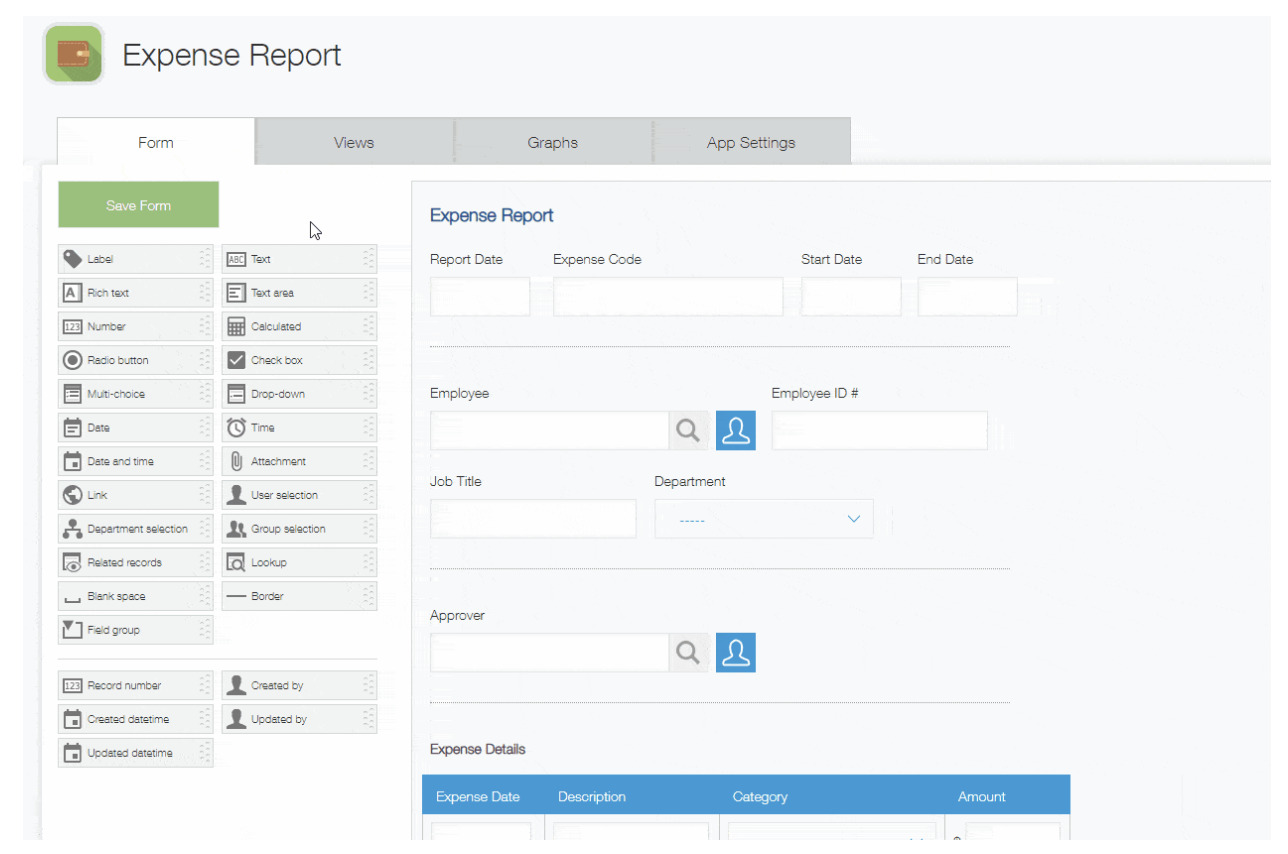
Kintone’s visual application builder is a platform that enables the drag-and-drop design of custom business apps for any workplace task or process. These apps can manage team data, workflows, and communications in one central place.
With zero code required, this application is a breath of fresh air to use. Users can start from scratch to build apps or customize existing templates that fit their needs. Users can leverage workflows to automate tasks and communicate with team members within task threads all while depending on built-in notifications and reminders never to miss a deadline.
Pros of Kintone
Granular permissions controls
This feature of Kintone allows businesses to manage who sees what data. That means while everyone may have access to the same data records, they may not see the same thing depending on the granular permissions assigned to certain records.
Single point of collaboration
Instead of trapping conversations across multiple touchpoints like emails, chats and so on, Kintone’s collaboration features allow you to communicate threaded onto your data and set up dedicated threads within each workspace to discuss specific topics or projects.
Replace spreadsheets with poor data validation
The poor data validation of spreadsheets makes data contained therein susceptible to corruption due to user mistakes. Kintone’s simple design makes it possible to replace such sheets with forms that capture, validate, and store data with fidelity.
Cons of Kintone
Steep learning curve
Kintone takes some getting used to achieving efficiency in the platform. For a process management suite that is meant to speed up execution, this is a major problem.
No public access to processes
If you need a process management platform that will provide access to both your internal and external audiences, Kintone might not be the best option for you as the processes here are only accessible by people within your organization.
Prohibitive pricing structure
Their per-user pricing weighs all users equally. This forces businesses to pay the same amount for those who depend on the platform for work, as well as those who only need occasional access.
Pricing
Unlike many automation apps with enterprise capabilities, Kintone is pretty transparent about its pricing.
Kintone is priced at $24 per user per month, with a minimum of five users. That means the lowest possible price point to use Kintone for your business is $120 monthly.
If you work for a nonprofit, educational, or government organization, Kintone offers a special discount for your organization.
In addition, their free trial, which can be taken in collaboration with team members, is extensible for thirty days after expiration.
CheckFlow

CheckFlow is an SaaS workflow management platform that enables businesses to create, optimize, and execute their business checklists and processes in real time.
The idea behind the tool was to create a process management tool that did not just work, but that people would enjoy using as well.
Some of the core features of the platform include template designer, checklists, recurring checklists, and automations.
Pros of CheckFlow
Process template version history
In CheckFlow, process templates have full version history. Process owners can view all previous versions and, if required, revert back to a specific version. Apart from allowing you to safely experiment with your processes in a bid to improve them, this also gives you the confidence that you will not inadvertently lose important changes to your process documents.
Unlimited guests and anonymous users
CheckFlow introduces the idea of billable and non-billable users. While administrators and members are billable, an unlimited number of guests and anonymous users can have limited access to your processes free of charge.
Good for time-sensitive processes
CheckFlow allows process owners to set up a sequence of tasks due reminder emails at different time frames. This makes it useful for time-sensitive processes as a sense of urgency is maintained throughout the process’s lifetime.
Cons of CheckFlow
Tasks must be coupled to a to-do list
In CheckFlow, you cannot create a standalone task. All tasks must be a part of a process. Clearly, this limitation does not mirror normal business practice as many tasks in a typical business are standalone and not part of a larger process.
Pricing
CheckFlow has two plans – Business and Enterprise.
The Business plan costs $10 per user per month for teams of any size, while the Enterprise plan goes for $18 per user per month, for a minimum of 5 users.
Both plans similarly give businesses access to unlimited checklists, templates and free guest users. A major difference, though, is that Business plan users have access to just 25GB of storage, while storage is unlimited for Enterprise plan users.
Why They Chose SweetProcess: A Review of Case Studies From Businesses Like Yours

So far, we have reviewed eight alternatives to Gluu in this article, highlighting the capabilities of each alternative, and making efforts to show their pros and cons in an objective manner.
Why?
As we stated at the onset of this article, we want to empower you to make the right decision.
Let’s consider a couple of case studies that will highlight business owners like you faced with choosing a process management software, and how making the right decision helped their businesses.
MiPA: From Dropbox Folders to SweetProcess
MiPA provides virtual PA support and calls answering services to businesses and executives in the UK.
Handling the communication needs of businesses, it was clear from the start that they had to hone everything down into processes so details didn’t fall through the cracks. This was especially critical because they handled a lot of personalized services for each customer.
When Dropbox could no longer serve as their process bucket, they turned to SweetProcess, and their experience was sweet! Emma Mills, owner and founder at MiPA, shares their experience:
“By the nature of what we do, we are carrying out lots of bespoke things for different businesses. It’s not just like we have one product and it’s done exactly the same way…. We have like 350, 400 customers now. SweetProcess has helped us to really scale up our service in a bespoke way. It’s enabled us to serve people in the way that they particularly want.”
Want to customize workflows for different clients? SweetProcess’ ease of use guarantees that it is a breeze. Start our 14-day free trial.
How ShipCalm Facilitated Growth and Employee Efficiency
Already a process-minded business leader, the CEO of ShipCalm, Ted Fogliani, started early searching for process automation software to improve efficiencies in his team. All tools he assessed, though, fell short in one aspect or the other until he discovered SweetProcess.
He recounts his experience:
“I had been hunting for years for something that was easy to do, and the thing that got me attracted to SweetProcess was that writing revision one of the procedures is the easiest thing in the market. I’ve looked at them all. Writing revision one was the easiest thing to do with these guys.”
Conclusion
In this review of eight alternatives to Gluu, we have presented some of the closest business process management software to Gluu. Our objective analysis is meant to empower you with the facts needed to make an informed choice.
Still confused?
If you want an enterprise-level, no-code app builder platform, you are better off with Workato, Pega Platform, or Kintone.
If you are big on BPMN, Pega Platform is the solution for you.
What if you are keen on a platform that is easy to use? Something that your users can jump on board with and start designing and executing complex processes in minutes, not months? SweetProcess, CheckFlow, Pipefy, and Kissflow are the alternatives to go with.
But if you need a process automation platform that is intuitive to use, suitable for small and mid-sized businesses, and has almost zero risk of breaking the bank, go with SweetProcess. None of the alternatives considered, not even Gluu, come close to matching SweetProcess’ flat-fee pricing structure.
Ready to bring order to your business and boost operational efficiencies without breaking the bank? Sign up for a 14-day free trial. No credit card is required.
